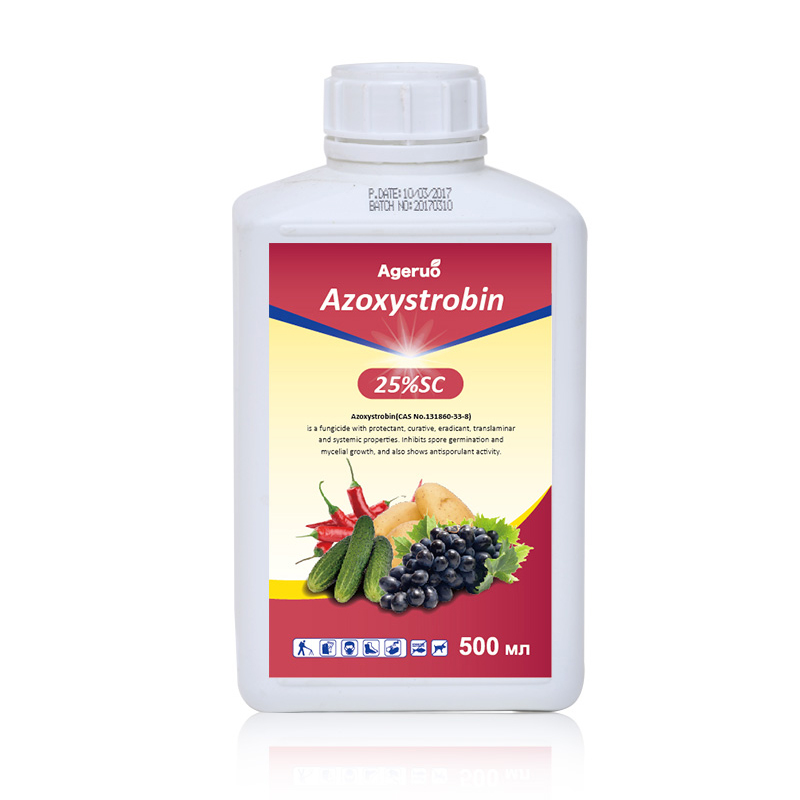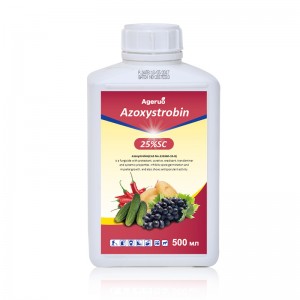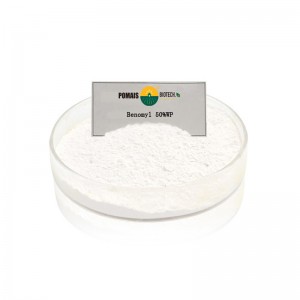Products
POMAIS Azoxystrobin 25% SC 250g/L | Fungicide & Bactericide
Introduction
| Active Ingredient | Azoxystrobin |
| Common Name | Azoxystrobin 25% SC |
| CAS Number | 131860-33-8 |
| Molecular Formula | C22H17N3O5 |
| Application | Can be used for foliar spray, seed treatment and soil treatment of grains, vegetables and crops |
| Brand Name | POMAIS |
| Shelf life | 2 Years |
| Purity | 50%WDG |
| State | Granular |
| Label | Customized |
| Formulations | 25%SC,50%WDG,80%WDG |
| The mixed formulation product | 1.azoxystrobin 32%+hifluzamide8% 11.7% SC2.azoxystrobin 7%+propiconazol 11.7% 11.7% SC3.azoxystrobin 30%+boscalid 15% SC4.azoxystrobin20%+tebuconazole 30% SC
5.azoxystrobin20%+metalaxyl-M10% SC |
Looking for the Latest Rhizoctonia Azoxystrobin Pricelist?
If you are sourcing a proven solution to protect your crops against Rhizoctonia and other key fungal diseases, our high-quality Azoxystrobin formulations can help you stay competitive in your market. We understand that price transparency, stable supply, and reliable performance are top priorities for your business.
At POMAIS, we provide clear Rhizoctonia Azoxystrobin pricelists, flexible OEM packaging options, and full registration support for global distributors. Whether you need bulk orders or customized labels for your local market, our experienced team is ready to support you every step of the way.
Contact us today to get your detailed Azoxystrobin price quote, request free samples, or discuss your next bulk shipment with our technical team. We are committed to helping you grow your business with consistent quality and competitive pricing.
Azoxystrobin 25% SC
Azoxystrobin is a systemic, broad-spectrum fungicide belonging to the strobilurin class (β-methoxyacrylates). It works by inhibiting mitochondrial respiration in fungal cells, specifically targeting Complex III (cytochrome bc1) in the electron transport chain. This unique mode of action results in energy depletion, leading to halted spore germination, inhibited mycelial growth, and ultimately fungal death.
1. Dual Preventive and Curative Action
- Preventive: Forms a protective barrier on the plant surface, stopping spores before infection starts
- Curative: Penetrates plant tissue and inhibits fungi in early stages of development
- Translaminar and systemic movement enables redistribution across leaf surfaces and into new tissue
2. Wide-Spectrum Efficacy
Azoxystrobin controls over 50 fungal diseases including:
- Downy mildew
- Late blight
- Anthracnose
- Sheath blight
- Rice blast
- Alternaria, Phytophthora, and Rhizoctonia spp.
Its effectiveness makes it a core product for:
- Grains: rice, wheat, maize
- Vegetables: potato, cucumber, pepper
- Fruits: grape, citrus, waxberry
- Specialty crops: pitaya, loquat, orchids
3. Resistance Management Role
- Classified under FRAC Group 11
- Suitable for use in rotation or tank mixes to reduce resistance buildup
- Compatible with many azole fungicides (e.g., propiconazole, tebuconazole)
4. Crop Safety and Quality Enhancement
- Promotes greener leaves, stronger photosynthesis, and better fruit set
- Supports improved crop yield and post-harvest quality
- No visible phytotoxicity when used as directed
Azoxystrobin’s combination of broad control, mobility within plants, and preventive-curative capability makes it a highly strategic tool in modern disease management programs.
Formulation and Usage Recommendations
At POMAIS, we supply Azoxystrobin in multiple formulations to suit varied agronomic needs, spray equipment, and regulatory environments. The most widely adopted formulation is Azoxystrobin 25% SC (250g/L), known for its excellent suspension stability, coverage, and rainfastness.
1. Available Formulations
- 25% SC (Suspension Concentrate) – Ideal for foliar spray
- 50% WDG / 80% WDG (Water Dispersible Granules) – Higher-concentration options for more compact handling
-
Mixtures Available:
- Azoxystrobin + Propiconazole
- Azoxystrobin + Tebuconazole
- Azoxystrobin + Metalaxyl-M
- Azoxystrobin + Boscalid
- Azoxystrobin + Hifluzamide
All formulations support OEM customization with private labels, packaging sizes, and regulatory labeling.
2. Recommended Use Rates and Application
| Formulation | Crop | Target Disease | Dosage (per ha) | Application Method |
|---|---|---|---|---|
| 25% SC | Potato | Late blight, black scurf | 100–375 g/ha | Foliar spray |
| 25% SC | Rice | Sheath blight | 100–375 g/ha | Foliar spray |
| 25% SC | Grape | Downy mildew | 100–375 g/ha | Foliar spray |
| 50% WDG | Citrus | Anthracnose, scab | 100–375 g/ha | Foliar spray |
| 50% WDG | Cucumber | Downy mildew | 100–375 g/ha | Foliar spray |
| 50% WDG | Pepper | Phytophthora blight | 100–375 g/ha | Foliar spray |
- Spray volume: 400–800 L water/ha depending on canopy density
- Apply at the first sign of disease or preventively under high-risk conditions
- Re-treatment interval: 7–14 days, depending on disease pressure and crop sensitivity
3. Application Best Practices
- Apply during cooler times of day, avoiding intense sunlight or impending rain
- Do not apply on stressed or wilted crops
- Ensure full leaf and fruit coverage for maximum efficacy
- For resistance management, alternate with different FRAC group fungicides
Azoxystrobin’s versatile formulations and field-proven performance make it suitable for season-long use, from seedling protection to late-stage disease suppression.
Target Crops and Fungal Diseases
Azoxystrobin 25% SC is known for its wide compatibility across crop types and its proven control of many economically damaging fungal diseases. It is frequently used in integrated fungicide programs to maintain yield, improve crop quality, and prevent early-season outbreaks.
1. Suitable Crops
Azoxystrobin is registered and used in:
- Cereal crops: Rice, wheat, barley, corn
- Vegetables: Potato, cucumber, tomato, onion, pepper, beans
- Fruits: Grapes, citrus, pitaya, loquat, waxberry
- Oilseeds: Peanut, soybean, sunflower
- Specialty crops: Orchids, herbs, turfgrass (under certain labels)
2. Fungal Diseases Effectively Controlled
| Disease Type | Scientific Group | Example Diseases Controlled |
|---|---|---|
| Downy mildew | Peronosporales | Grapes, cucumber, soybean |
| Late blight | Phytophthora infestans | Potato, tomato |
| Sheath blight | Rhizoctonia solani | Rice |
| Anthracnose | Colletotrichum spp. | Citrus, pitaya, mango, pepper |
| Rice blast | Magnaporthe oryzae | Rice |
| Alternaria leaf spot | Alternaria solani / spp. | Potato, tomato, carrots |
| Black scurf | Rhizoctonia spp. | Potato, carrots |
| Fruit rot and brown spot | Monilinia, Gloeosporium spp. | Waxberry, citrus, stone fruits |
3. Performance Highlights
- Multi-site crop safety: Suitable for foliar and soil contact crops
- Wide environmental adaptability: Performs well in both humid and dry regions
- Reduced incidence of secondary infections due to translaminar protection
Azoxystrobin provides broad-spectrum protection for high-value fruits, vegetables, and staple grains, making it a preferred choice for regional distributors, national agro programs, and export-oriented growers.
Packaging and OEM Options

At POMAIS, we understand that successful product distribution requires more than technical performance—it demands strong branding, packaging convenience, and regulatory adaptability. That’s why we offer fully flexible OEM/ODM packaging and label solutions for Azoxystrobin 25% SC and its related formulations.
1. Retail and Commercial Packaging Options
Retail Sizes – For agri-dealers and direct-to-farmer sales:
- 100ml, 250ml, 500ml, 1L HDPE / CO-EX / PET bottles
- Optional: measuring caps, child-safe lids, shrink-wrap film
Bulk Sizes – For commercial farms, tenders, and large applications:
- 5L, 10L, 20L plastic drums with chemical-resistant inner lining
- 200L plastic or iron drums for consolidated distribution
- IBC tanks available for industrial clients or container-scale shipping
2. Labeling and Branding Customization
We support private label programs that reflect your market identity:
- Multilingual printing (English, Arabic, Spanish, French, Russian, etc.)
-
Label content can include:
- Local authority-required fields (dose, PHI, safety)
- GHS pictograms and signal words
- Nutrient/drug interaction info for combo formulations
Anti-counterfeit options available:
- QR code tracking
- Serial-numbered holograms
- Tamper-evident seals
3. Export-Ready Documentation and Compliance
To facilitate seamless import and local market registration, we provide:
- COA, MSDS, TDS
- SGS batch testing
- GLP toxicology and residue data (where required)
- Support for ICAMA-based registration or country-specific dossiers
We also help partners manage:
- UN-standard packaging
- Marine insurance and customs declarations
- FCL / LCL logistics support with short lead times
Whether you're entering a price-sensitive retail market or managing a tender-based procurement program, our packaging and OEM services are engineered to deliver reliability, customization, and market impact.
Mode of Action
Azoxystrobin is classified as a strobilurin fungicide (FRAC Group 11). Its primary mode of action is the inhibition of mitochondrial respiration in fungal pathogens, specifically at Complex III of the electron transport chain (cytochrome bc1 complex).
1. How It Works in Fungal Cells
- Azoxystrobin binds to the Qo site of the fungal mitochondria.
- This blocks electron transfer within the respiratory chain.
- Without ATP generation, the fungal cell is deprived of energy.
- The result: rapid cessation of growth, halted spore germination, and fungal death.
This action is effective at multiple disease stages—pre-infection, early development, and post-infection—making Azoxystrobin both a protectant and early curative fungicide.
2. Systemic and Translaminar Movement
- After foliar application, Azoxystrobin penetrates the cuticle and moves within the leaf tissue (translaminar action).
- It also moves acropetally (upward) through xylem, protecting new leaves and growth points.
- This makes it especially effective in crops with rapid vegetative growth or long harvest windows.
3. Resistance Management Benefits
- Works at a specific biochemical target, making it highly effective at low rates.
- When used alone, it carries a moderate risk of resistance development.
-
Best used in:
- Rotation with multi-site fungicides or azoles (e.g., tebuconazole)
- Mixtures (e.g., Azoxystrobin + Metalaxyl-M or Propiconazole)
Azoxystrobin’s unique action helps reduce the frequency of application, and when combined strategically, delays the emergence of resistant pathogen populations.
Azoxystrobin’s mode of action makes it a cornerstone molecule in many integrated fungicide programs, balancing broad control, systemic protection, and compatibility with modern crop management needs.
Related reading: Azoxystrobin and Propiconazole Fungicide Rotation
Suitable crops:

Act on these Pests:

Application Guidelines
Proper application of Azoxystrobin 25% SC ensures full expression of its preventive and curative activity. This section provides detailed usage guidance to help distributors advise clients and farmers on how to use the product safely and effectively.
1. When to Apply
- Apply preventively or at the first visible signs of infection
- In disease-prone areas or seasons, begin applications before environmental conditions favor outbreaks (e.g., high humidity, leaf wetness)
- Repeat at 7–14 day intervals, depending on disease pressure and crop growth rate
2. Application Method
-
Foliar Spray (main method):
- Use flat-fan nozzles for even leaf coverage
- Spray during early morning or late afternoon to reduce evaporation
- Seed Treatment (for systemic startup protection): use appropriate formulation
- Soil Drenching (for root and crown diseases): use under specific guidance
3. Dilution and Spray Volume
| Crop Type | Water Volume | Spray Pressure | Coverage Goal |
|---|---|---|---|
| Field crops | 200–400 L/ha | 2.5–3 bar | Complete leaf wetting, no runoff |
| Fruit/vegetables | 400–800 L/ha | 3–4 bar | Thorough canopy coverage |
- Stir or agitate solution continuously during application
- Use clean water, and avoid strong acids/alkalis in tank mix
4. Pre-Harvest Interval (PHI) and Re-entry Interval (REI)
-
PHI:
- Rice, vegetables: 14 days
- Fruits (grape, citrus): 21 days
-
REI:
- Minimum 12 hours (longer if in enclosed areas)
5. Mixing and Compatibility
- Compatible with most systemic and contact fungicides, as well as insecticides and foliar fertilizers
- Do not mix with products that have strong alkaline pH or copper-based fungicides without prior testing
- For tank-mixing: Always conduct a jar test and add Azoxystrobin last, after dilution
6. Safety Tips
- Wear PPE: gloves, goggles, long sleeves, and mask
- Do not apply when rain is expected within 2–3 hours
- Keep unused spray solution away from water sources
- Clean sprayers thoroughly after use
Advantages
Azoxystrobin 25% SC (250g/L) is one of the most successful and widely adopted fungicides globally, combining broad-spectrum control, low toxicity, crop safety, and multi-formulation flexibility. As a supplier, POMAIS enhances this value with OEM services and full registration support, giving partners the tools to scale quickly and confidently.
1. Dual Action: Preventive and Curative
- Stops disease before infection and controls pathogens already in the plant
- Helps reduce future outbreaks, especially in high-humidity regions
- Can be used throughout the season, from vegetative to fruiting stages
2. Broad Disease Spectrum and Multi-Crop Use
- One product controls over 50 types of fungal diseases
- Suitable for grains, vegetables, fruits, and specialty crops
- Flexible application methods: foliar spray, soil treatment, seed dressing
This wide adaptability supports diverse distributor portfolios and allows for consolidated inventory across crops.
3. Low Use Rate, High Return
- Effective at 100–375 g/ha, lowering per-hectare cost
- Strong residual action, reducing spray frequency
- Quick visual results improve farmer satisfaction and brand loyalty
4. Formulation and Branding Flexibility
- Available in SC, WDG, and custom mixtures
-
Supports:
- Private label (OEM)
- Custom bottle types (100ml to 200L)
- Multilingual labels for global markets
Mixed formulations with propiconazole, tebuconazole, and boscalid allow you to position value-added fungicide blends.
5. Full Technical and Regulatory Support
- COA, MSDS, SGS reports available
- GLP toxicology and residue data for local registration
- Experienced team offers fast documentation and ICAMA guidance
- Proven on-time delivery and stable supply capacity
Whether you're serving national distributors, retail agro-dealers, or government procurement programs, Azoxystrobin 25% SC is a high-conversion, high-retention product built for both performance and growth.
Storage and Safety Information
Azoxystrobin 25% SC is a low-toxicity, broad-use fungicide; however, it is still classified as a pesticide and must be handled with appropriate precautions. Following proper storage and safety protocols ensures long shelf life, environmental protection, and user safety.
1. Storage Conditions
- Store in original, sealed containers
- Keep in a cool, dry, and well-ventilated place
-
Avoid exposure to:
- Direct sunlight
- High humidity
- Temperatures above 40°C or below 0°C
- Do not store near food, feed, or drinking water
- Separate from oxidizing agents or strong alkaline materials
Properly stored, Azoxystrobin maintains stability for up to 2 years.
2. Safe Handling During Use
-
Wear protective gear:
- Long-sleeved clothing
- Gloves
- Goggles
- Face mask or respirator when spraying in enclosed or high-volume areas
-
Avoid:
- Inhaling mist or vapor
- Direct contact with skin or eyes
- Eating, drinking, or smoking during handling
- Wash hands and face thoroughly after application
3. First Aid Measures
| Exposure Type | Action |
|---|---|
| Skin contact | Rinse thoroughly with soap and water for at least 15 minutes |
| Eye contact | Rinse eyes with clean water for 15–20 minutes and seek medical attention |
| Inhalation | Move to fresh air and monitor for respiratory distress |
| Ingestion | Do not induce vomiting; rinse mouth and seek medical advice immediately |
Keep MSDS and product label on hand when transporting or using the product.
4. Environmental Safety
- Toxic to aquatic organisms—avoid spray drift to water bodies
- Do not apply in areas with active fish farming or bee hives
- Prevent runoff into ditches or irrigation channels
- Triple-rinse empty containers and dispose of according to local regulations
- Do not reuse containers
Frequently Asked Questions (FAQ)
1. What is Azoxystrobin 25% SC used for?
Azoxystrobin 25% SC is a systemic fungicide used to control a wide range of fungal diseases including downy mildew, late blight, anthracnose, sheath blight, rice blast, and more. It can be applied on vegetables, fruits, cereals, and oilseed crops.
2. How does it work?
It inhibits mitochondrial respiration in fungi, stopping energy production and leading to cell death. It acts preventively and curatively, with translaminar movement and partial systemic activity through the plant’s vascular system.
3. What are the available formulations?
We provide:
- 25% SC (Suspension Concentrate)
- 50% and 80% WDG (Water Dispersible Granules)
- Mixed formulations such as Azoxystrobin + Propiconazole, Azoxystrobin + Tebuconazole, etc.
All formulations support OEM, white-label, and multilingual packaging.
4. What crops can it be used on?
Azoxystrobin is registered for:
- Rice, wheat, corn
- Potato, cucumber, tomato, pepper
- Grapes, citrus, waxberry
- Soybean, peanut, turfgrass
Applicable crops vary by country; always refer to local labels or regulatory guidance.
5. What’s the recommended dosage?
- Typical dosage: 100–375 g/ha
- Spray volume: 200–800 L/ha, depending on crop and canopy density
- Interval between sprays: 7–14 days
6. Is it safe for crops?
Yes. When used as directed, Azoxystrobin is highly crop-safe, with no visible phytotoxicity. Avoid application during heat stress or on severely damaged plants.
7. Can it be mixed with other products?
Yes. Azoxystrobin is compatible with:
- Most fungicides (e.g., azoles)
- Many insecticides and foliar nutrients
Avoid mixing with highly alkaline or copper-based products unless a jar test confirms compatibility.
8. What is the shelf life?
2 years from manufacturing when stored in original, sealed packaging under cool, dry conditions.
9. What packaging options do you offer?
We offer:
- Retail: 100ml, 250ml, 500ml, 1L
- Bulk: 5L, 10L, 20L, 200L drums
- OEM and private-label service with custom bottle, label, and box designs
10. Do you provide support for registration?
Yes. We supply:
- COA, MSDS, TDS
- GLP toxicology and residue studies
- ICAMA registration data
- Customized dossier assistance for local compliance
















